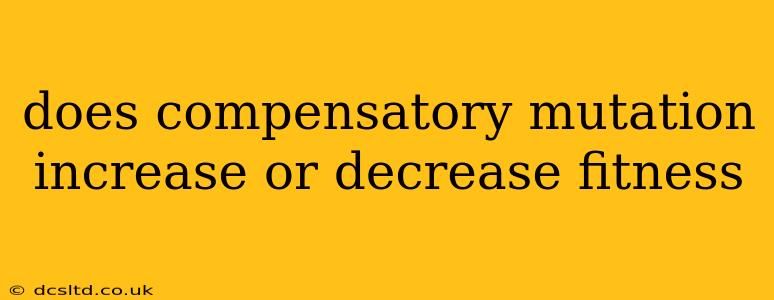Does Compensatory Mutation Increase or Decrease Fitness?
Compensatory mutations are genetic changes that mitigate the negative effects of a deleterious mutation. Understanding their impact on fitness is crucial for comprehending evolutionary processes and disease mechanisms. While intuitively, one might expect compensatory mutations to increase fitness, the reality is more nuanced. The effect on fitness depends on several interconnected factors.
Understanding Compensatory Mutations:
A deleterious mutation reduces an organism's fitness, meaning its ability to survive and reproduce. This could manifest as a reduced growth rate, impaired function of a protein, or increased susceptibility to disease. A compensatory mutation, often arising independently, interacts with the initial deleterious mutation to partially or fully restore the organism's fitness. This interaction can be direct (e.g., restoring protein structure) or indirect (e.g., altering gene expression to compensate for the loss of function elsewhere).
How Compensatory Mutations Affect Fitness:
The impact of a compensatory mutation on fitness can be:
-
Increased Fitness: This is the most common outcome. The compensatory mutation effectively reverses, or at least partially ameliorates, the detrimental effects of the initial mutation, leading to a net increase in fitness compared to the organism carrying only the deleterious mutation. This restoration can bring fitness back to the level of the wild-type (unmutated) organism or even potentially beyond.
-
No Change in Fitness: In some cases, the compensatory mutation might fully restore the fitness lost due to the deleterious mutation. The organism returns to its pre-mutation fitness level, showing no net change in fitness.
-
Decreased Fitness: While less common, a compensatory mutation can, in certain scenarios, lead to a further decrease in fitness. This could occur if the compensatory mutation has its own negative consequences that outweigh the benefits it provides in counteracting the initial deleterious mutation. This might happen if the compensatory mutation introduces instability elsewhere in the genome, alters other crucial pathways, or creates a novel disadvantage.
Factors Influencing the Effect on Fitness:
Several factors determine whether a compensatory mutation increases, decreases, or has no effect on fitness:
-
The Severity of the Initial Deleterious Mutation: A severely deleterious mutation might require a strong compensatory mutation for any fitness recovery. Conversely, a mildly deleterious mutation might be compensated for easily, resulting in a faster return to near-wild-type fitness.
-
The Nature of the Interaction between Mutations: The way the compensatory mutation interacts with the original mutation significantly impacts the outcome. A direct interaction (e.g., restoring protein function) is likely to yield a stronger positive effect on fitness than an indirect interaction (e.g., altering gene regulation).
-
The Genetic Background: The genetic context in which the mutations occur influences their expression and interaction. The presence of other mutations, beneficial or deleterious, could modulate the effect of the compensatory mutation.
-
The Environmental Context: Environmental factors can influence how the mutations affect fitness. A mutation that confers an advantage in one environment might be neutral or even deleterious in another.
Examples of Compensatory Mutations:
Compensatory mutations are observed across various biological systems, from viruses to humans. For example, mutations in viral proteins that initially lead to reduced infectivity can be followed by further mutations that enhance viral fitness again. Similarly, studies have shown compensatory mutations arising in human genes associated with inherited diseases.
What about the "People Also Ask" questions?
Unfortunately, search engines did not return a "People Also Ask" section for this query, preventing the inclusion of those questions as subheadings in this response. The focus, therefore, has been on comprehensively addressing the core question's nuances and associated contextual factors.
